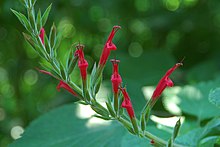| Salvia elegans | |
|---|---|

| |
| Scientific classification | |
| Kingdom: | Plantae |
| Clade: | Tracheophytes |
| Clade: | Angiosperms |
| Clade: | Eudicots |
| Clade: | Asterids |
| Order: | Lamiales |
| Family: | Lamiaceae |
| Genus: | Salvia |
| Species: | S. elegans |
| Binomial name | |
| Salvia elegans Vahl | |
| Synonyms | |
|
Salvia rutilans Carrière | |
Salvia elegans, a species with several varieties including pineapple sage and tangerine sage, is a perennial shrub native to Mexico.
Description
Salvia elegans Pineapple Sage has tubular red flowers and an attractive scent to the leaves that is similar to pineapple. It produces numerous erect leafy stems up to 150 centimetres (59 in) and flowers in the late autumn. It is a short-day plant. The flowering season in Mexico is August onward; further north it may not flower till later autumn, and if there is no frost, it may flower until spring.
The variety "Honey Melon", which has the same pineapple fragrance in the leaves, blooms early in the summer, rather than in autumn.
Salvia elegans Tangerine Sage grows to about 60–90 cm (24–35 in) tall, has bronze edged leaves and a citrus scent. It is summer flowering.
Phytochemistry
The essential oil of S. elegans consists primarily of caffeic acid and its derivatives, such as rosmarinic acid and salvianolic acid, and flavones.
Distribution and habitat
Native to Mexico, the shrub inhabits Madrean and Mesoamerican pine–oak forests between 6,000 and 9,000 ft (1,800 and 2,700 m).
Ecology
The red flowers are attractive to hummingbirds and butterflies. In a highland temperate forest in central Mexico, pineapple sage was found to be one of the three most-visited species by hummingbirds.
Cultivation
Pineapple sage was introduced into horticulture about 1870. In cultivation, it typically reaches a height of 1.2 to 1.5 metres (4 to 5 ft), with its roots spreading underground to form a large clump. The pale yellow-green leaves are veined and covered with fine hairs. Six to twelve scarlet flowers grow in whorls, featuring a long inflorescence that blooms gradually and lasts for an extended period. With a hard frost, the plant will die down to the ground and grow back the following spring.
Uses
The leaves and flowers are edible. The plant is used in Mexican traditional medicine, especially for anxiety and hypertension.
References
- Epic Gardening: Salvia Elegans
- / Monty Don: Sage concern
- ^ Clebsch, Betsy; Barner, Carol D. (2003). The New Book of Salvias. Timber Press. pp. 115–117. ISBN 978-0-88192-560-9.
- / Langthorn's Plantery: Salvia Elegans Tangerine
- Pereira, Olívia R.; Catarino, Marcelo D.; Afonso, Andrea F.; Silva, Artur M. S.; Cardoso, Susana M. (2018). "Salvia elegans, Salvia greggii and Salvia officinalis Decoctions: Antioxidant Activities and Inhibition of Carbohydrate and Lipid Metabolic Enzymes". Molecules. 23 (12): 3169. doi:10.3390/molecules23123169. PMC 6321363. PMID 30513773.
- Lara, Carlos (Mar 2006). "Temporal dynamics of flower use by hummingbirds in a highland temperate forest in Mexico". Écoscience. 13 (1): 23–29. doi:10.2980/1195-6860(2006)13[23:TDOFUB]2.0.CO;2.
- Hanson, Beth (2001). Gourmet Herbs. Brooklyn Botanic Garden. p. 90. ISBN 978-1-889538-21-1.
- Herrera-Ruiza, Maribel; García-Beltrána, Yolanda; Morab, Sergio; Díaz-Véliz, Gabriela; Vianac, Glauce S.B.; Tortorielloa, Jaime; Ramíreza, Guillermo (Aug 2006). "Antidepressant and anxiolytic effects of hydroalcoholic extract from Salvia elegans". Journal of Ethnopharmacology. 107 (1): 53–8. doi:10.1016/j.jep.2006.02.003. PMID 16530995.